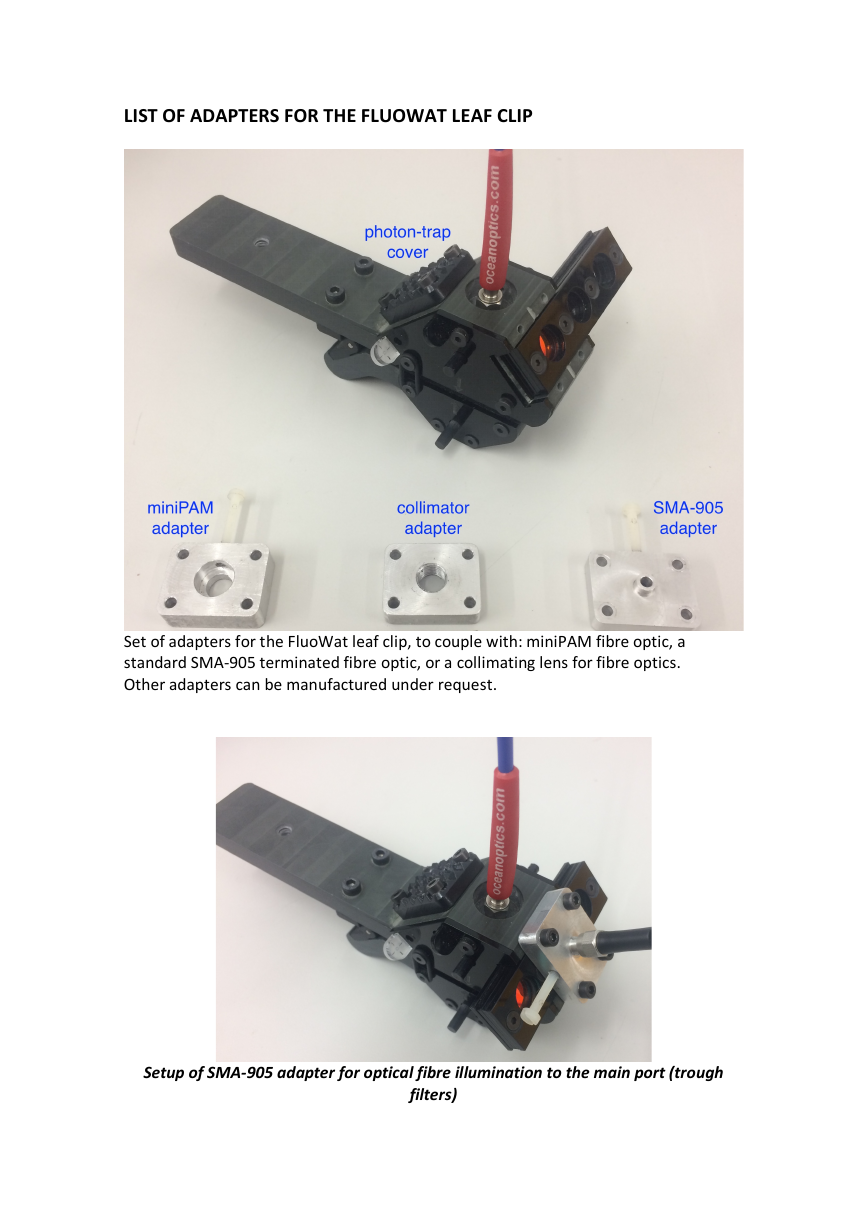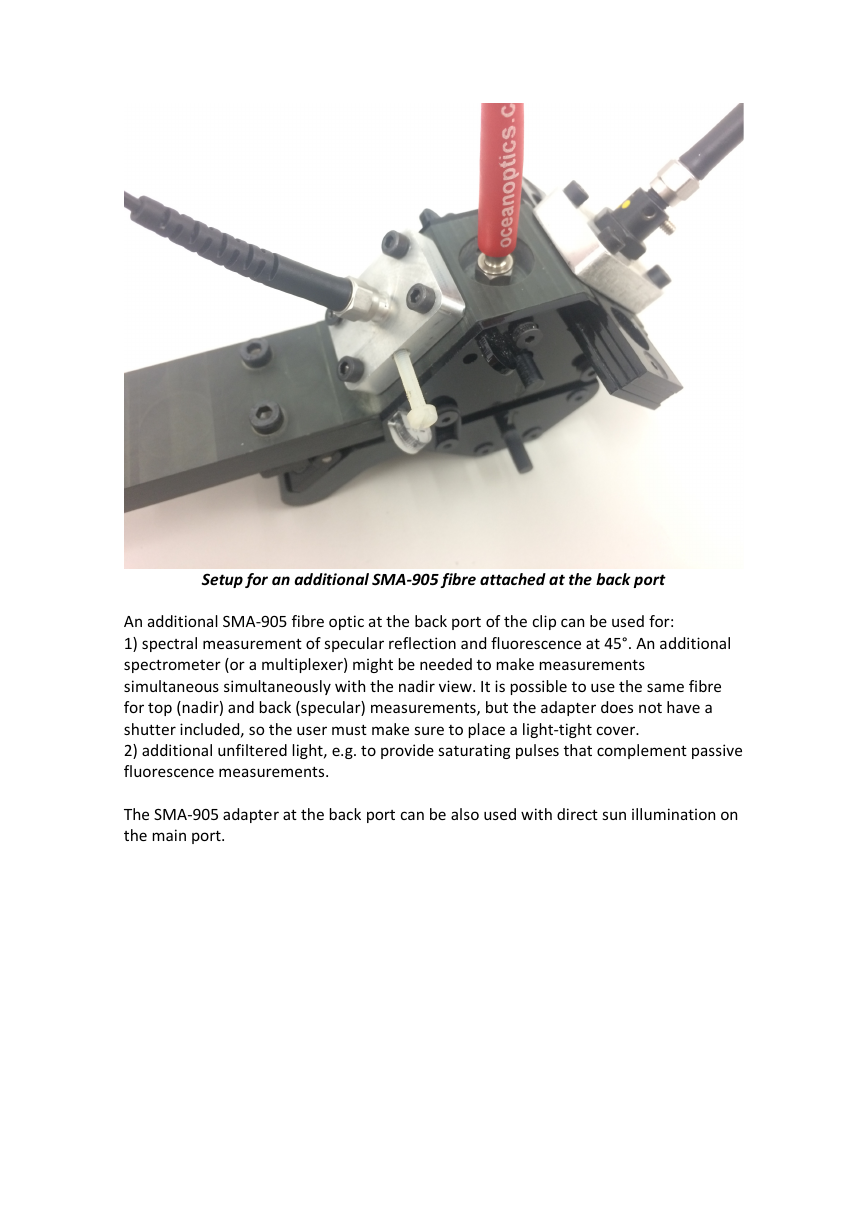LIST OF ADAPTERS FOR THE FLUOWAT LEAF CLIP
Set of adapters for the FluoWat leaf clip, to couple with: miniPAM fibre optic, a
standard SMA-905 terminated fibre optic, or a collimating lens for fibre optics.
Other adapters can be manufactured under request.
Setup of SMA-905 adapter for optical fibre illumination to the main port (trough
filters)
�
Setup of collimating lens adapter for optical fibre illumination to the main port
(trough filters).
The adaptor has a UNF 3/8”-24 thread that fits commercially available collimating
lenses (not included). Collimating lenses can augment the light intensity over the
measuring spot in the leaf, at the expense of reducing the illuminated area. Current
design ensures that the measuring area is fully illuminated by the collimating lens
when using a measuring fibre with 0.22 numerical aperture, but any misalignment
might result in loss of signal. It might be necessary to adjust the focus of the
collimating lens. Collimating lenses are not provided with the FluoWat clip, and the
user should make sure that alignment a focus are properly set.
Common commercially available collimating lenses are: 74-series from OceanOptics, or
COL-VIS from Avantes, but any other with the same thread would fit.
�
Setup for an additional SMA-905 fibre attached at the back port
An additional SMA-905 fibre optic at the back port of the clip can be used for:
1) spectral measurement of specular reflection and fluorescence at 45°. An additional
spectrometer (or a multiplexer) might be needed to make measurements
simultaneous simultaneously with the nadir view. It is possible to use the same fibre
for top (nadir) and back (specular) measurements, but the adapter does not have a
shutter included, so the user must make sure to place a light-tight cover.
2) additional unfiltered light, e.g. to provide saturating pulses that complement passive
fluorescence measurements.
The SMA-905 adapter at the back port can be also used with direct sun illumination on
the main port.
�
Setup for miniPAM conection through the back port.
MiniPAM can be used to measure active and passive fluorescence simultaneously,
and/or to produce saturating pulses to complement passive fluorescence
measurements.
The only limitations being that it cannot record leaf temperature nor PAR, since these
sensors are located in miniPAM’s clip and cannot be removed. However, you can
estimate PAR from the Fluowat measurements of the white reference.
Other custom adapters can be manufactured under request.
�








 2023年江西萍乡中考道德与法治真题及答案.doc
2023年江西萍乡中考道德与法治真题及答案.doc 2012年重庆南川中考生物真题及答案.doc
2012年重庆南川中考生物真题及答案.doc 2013年江西师范大学地理学综合及文艺理论基础考研真题.doc
2013年江西师范大学地理学综合及文艺理论基础考研真题.doc 2020年四川甘孜小升初语文真题及答案I卷.doc
2020年四川甘孜小升初语文真题及答案I卷.doc 2020年注册岩土工程师专业基础考试真题及答案.doc
2020年注册岩土工程师专业基础考试真题及答案.doc 2023-2024学年福建省厦门市九年级上学期数学月考试题及答案.doc
2023-2024学年福建省厦门市九年级上学期数学月考试题及答案.doc 2021-2022学年辽宁省沈阳市大东区九年级上学期语文期末试题及答案.doc
2021-2022学年辽宁省沈阳市大东区九年级上学期语文期末试题及答案.doc 2022-2023学年北京东城区初三第一学期物理期末试卷及答案.doc
2022-2023学年北京东城区初三第一学期物理期末试卷及答案.doc 2018上半年江西教师资格初中地理学科知识与教学能力真题及答案.doc
2018上半年江西教师资格初中地理学科知识与教学能力真题及答案.doc 2012年河北国家公务员申论考试真题及答案-省级.doc
2012年河北国家公务员申论考试真题及答案-省级.doc 2020-2021学年江苏省扬州市江都区邵樊片九年级上学期数学第一次质量检测试题及答案.doc
2020-2021学年江苏省扬州市江都区邵樊片九年级上学期数学第一次质量检测试题及答案.doc 2022下半年黑龙江教师资格证中学综合素质真题及答案.doc
2022下半年黑龙江教师资格证中学综合素质真题及答案.doc